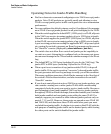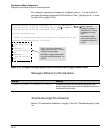
10-30
Port Status and Basic Configuration
Configuring Port-Based Priority for Incoming Packets
■ A tagged packet with an 802.1p priority setting (0 - 7) coming into the
switch on port 10 and leaving the switch through any other port configured
as a tagged VLAN member would keep its original priority setting (regard-
less of the port-based priority setting on port 10).
Note For a packet to carry a given 802.1p priority level from end-to-end in a network,
the VLAN for the packet must be configured as tagged on all switch-to-switch
links. Otherwise, the tag is removed and the 802.1p priority is lost as the packet
moves from one switch to the next.
Operating Rules for Port-Based Priority
These rules apply to the operation of port-based priority on the switch.
■ In the switch’s default configuration, port-based priority is configured as
“0” (zero) for inbound traffic on all ports.
■ On a given port, when a port-based priority is configured (0 - 7), an
inbound, untagged packet is assigned the specified priority and is sent to
the corresponding outbound priority queue on the outbound port. (See
table 10-3, “Mapping Priority Settings to Outbound Port Queues”, on page
10-29.) If the outbound port is a tagged member of a VLAN, then the packet
carries a tag with that priority setting to the next downstream device.
■ On a given port, an inbound, tagged packet received on the port with a
preset priority (0 - 7) in its tag maintains that priority and is assigned to
an outbound queue on the basis of that priority (regardless of the port-
based priority configured on the port). (Refer to table 10-3, “Mapping
Priority Settings to Outbound Port Queues” on page 10-29.)
■ If a packet leaves the switch through an outbound port configured as an
untagged member of the packet’s VLAN, then the packet leaves the switch
without a VLAN tag and thus without an 802.1p priority setting.
■ Trunked ports do not allow non-default (1 - 7) port-based priority settings.
If you configure a non-default port-based priority value on a port and then
add the port to a port trunk, then the port-based priority for that port is
returned to the default “0”.


















